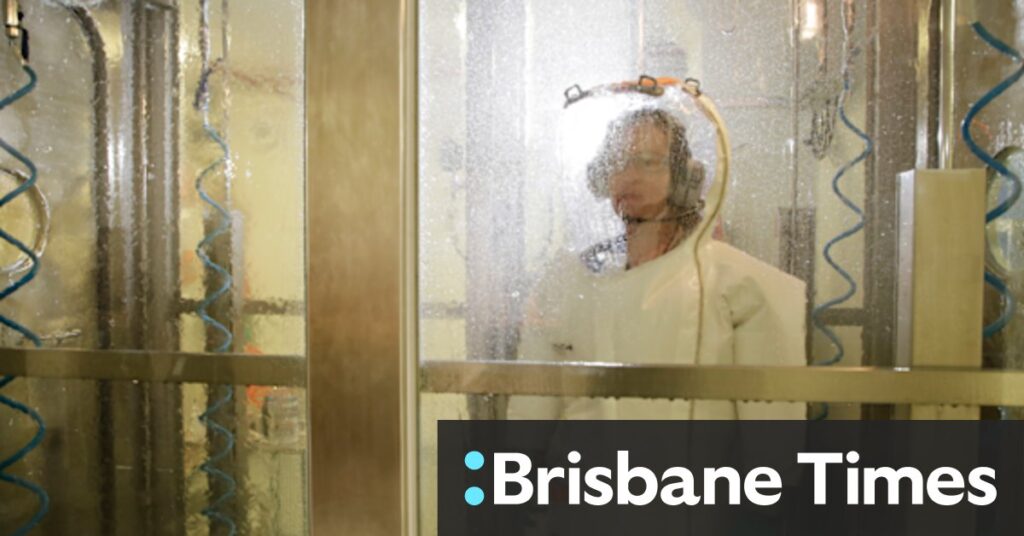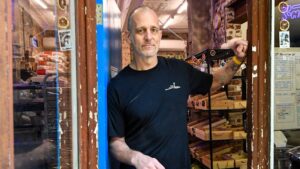
For all the trouble they cause, there are just 270 different types of viruses that can infect humans. Most have jumped to us at some point from the animals we share the planet with. That only leaves about 319,781 viruses in mammals that haven’t yet jumped. Add in birds, and the number swells to around 1.7 million.
Zoonosis is a numbers game. As we continue to change the climate, pushing animals and humans ever closer together, the numbers become more and more stacked against us. At the forefront of preparing for these potential threats is the Australian Centre for Disease Preparedness (ACDP), a sprawling complex of ultra-high-security labs fenced off on the outskirts of Geelong. They have never been busier.
Inside the High-Security Lab
Journalists are rarely granted access to the ACDP; this is the first time in many years a tour of the sealed inner sanctum has been granted by CSIRO. The lab works with hendra and dengue, pandemic bird flu, and ebola. The “no-smoking” signs plastered everywhere seem ironic given the far worse dangers lurking inside.
To enter, visitors must strip off and push past two-inch-thick metal doors into an airlock, which closes with a hiss. Nothing can come in, and nothing can leave; the door remains locked until a decontamination shower is completed. Inside, visitors dress in blue scrubs and white New Balances—a prison uniform fit for what is essentially a prison for viruses.
The Fortress-Like Design
ACDP is a Biosafety Level 4 lab—among the most secure labs in the world, designed for handling the most lethal pathogens. It is a box within a box within a box, each layer more secure than the last. The 30-centimeter thick walls are fashioned from nuclear-reactor-grade concrete. There are two separate electrical connections, two diesel generators as backup, and a third generator for added security. Some 70,000 liters of water are kept in a water tower as a fail-safe to feed sprinklers and decontamination showers if a fire coincides with a blackout.
The plant’s sewerage system occupies two entire floors; another is dedicated to air filters that suck the oxygen from the central labs. The air pressure slowly reduces as one journeys toward the inner sanctum.
“If we decided to put a big hole in the wall, everything flows in, not out,” says operations science coordinator Warren Michell.
The Human Element
At the facility’s BSL-4 heart, scientists must work in bubble suits made of vinyl that is thick, hot, and claustrophobic, with a plastic window to bang your head against. They have piped air; if the double-redundant air supply is cut off, there are about 2½ minutes to get to safety.
“When you are in this environment, you are a long, long way from getting help,” says bio-risk pathogens specialist Shane Riddell.
Some people try on the suits and rip them off almost immediately, the claustrophobia too much. Others are ruled out by a mandatory psych exam. “It’s just to make sure we’re not going to go rogue,” says experimental scientist Jennifer Barr.
For the elite few selected to work in bubble suits, there is a grueling training phase: practicing oxygen cut-offs or suit-rips, training dexterity through thick gloves on Jenga blocks and games of Operation. “Everything is slower,” says Barr. The work is tiring, “physically but also mentally because we are switched on all the time.”
Facing the Threats
The researchers are matter-of-fact about the risks of working directly with lethal viruses. “You don’t really think about it like that,” says Michell. “It’s just part of what you do.” But their fears lurk in their subconscious. Barr often dreams of walking into BSL-4 and then realizing she’s not wearing her bubble suit.
Her work perfectly encapsulates the threat we face. In 2022, she pulled a brand new henipavirus out of a flying fox urine sample taken from Queensland in 2011. “In the lab, it is able to infect human cells. The potential is there, but at this stage, there has been no evidence of any disease.”
“The threats are increasing, because of climate change, because of more global movement of people, animals, and products. We’re not going to really significantly change those,” says Dr. Debbie Eagles, the facility’s director.
To Salt Gully Virus, one can add the southward creep of African swine fever, the unexpected and fatal emergence in 2022 of Japanese Encephalitis, and Dengue. Scientists at ACDP worry about viruses you haven’t even heard of, like Chikungunya.
Unprecedented Outbreaks
Australia has its own bird flu, which continues to circulate in wild birds and spill over into chickens. In wild birds, it does not cause severe disease, but in chickens, it can mutate into something much nastier.
“What’s really unusual and unprecedented is in the last 18 months we’ve had four independent outbreaks,” says Dr. Matthew Neave, who leads the sequencing and agent characterization team; there were only eight before ever detected.
Many of these viruses are carried by mosquitoes; their range will only spread as climate change warms the world. Dr. Prasad Paradkar is trying to work out how far and how fast by keeping colonies of mosquitoes in ever-warmer boxes.
The Ethical Dilemma
Some researchers keep pictures of their children on lab windows. Paradkar has pictures of mosquitoes showing their needle-like proboscis. “I love them,” he says. “Their biology, when you look at them under a microscope, they are beautiful.”
He is less fond of a buzzing colony of striped Asian tiger mosquitoes. “They are really aggressive. We call them barbecue stoppers,” he says. “Even when we put our hand in to manipulate the experiment, they go right for it.” They can spread Chikungunya, Ross River fever, or dengue.
Sometimes, the news is better. In 2020, Eagles got a call from a vet on a Victorian farm full of sick emus. A sample was rushed to ACDP, where the team determined the birds had bird flu. A bird flu diagnosis is devastating, as it can lead to the culling of an entire herd to prevent transmission. But ACDP continued their work and discovered, in the virus’s genes, evidence it was only a low-risk variant. “We were able to save most of those emus,” says Eagles.
Lessons from COVID-19
ACDP also played a key but unheralded role in the world’s COVID response. In the most secure animal lab, marked ZOONOSIS ROOM, Eagles shows rows of wire cages—perhaps the riskiest part of the entire facility. This room holds animals deliberately infected with lethal viruses. The only thing between them and the scientists are bubble suits.
When COVID struck, the world needed to know how the virus reproduced and spread. ACDP was the first facility in the world to bring in ferrets—wiry little animals with remarkably similar flu symptoms to humans—and infect them. The animals are often injected with a microchip that can monitor their temperature, but often the best clues an animal is seriously sick are behavioral.
“Ferrets are really playful,” says Michell. “They’re just not as active, they are lying on their bed, they are just not that interested in you.”
Some of ACDP’s employees are vets. Others, like Paradkar, clearly love the creatures they study. But cut through the technical language, and the job here is tough: they are deliberately sickening, and then killing, animals.
“They don’t suffer. We work with them only to the point of not suffering,” says Eagles. “We don’t push it beyond the point where it’s ethically not appropriate.”
From those early ferret studies, scientists learned a lot about how the virus sickened and spread. Vials of the under-development COVID vaccine from AstraZeneca were shipped here from the UK. ACDP researchers showed the jabs offered good protection against the virus.
To exit the facility, we dump our clothing and shower for three minutes, as a light flashes above us. Eventually, when it is decided we are clean enough, the airlock decompresses, and we stumble out into sunlight. The thick doors slam closed behind us. Who knows when the next journalists will be let in?
“We’re not in the news much, because we prevent things,” says Eagles. “The better we do, the less media we get.”






